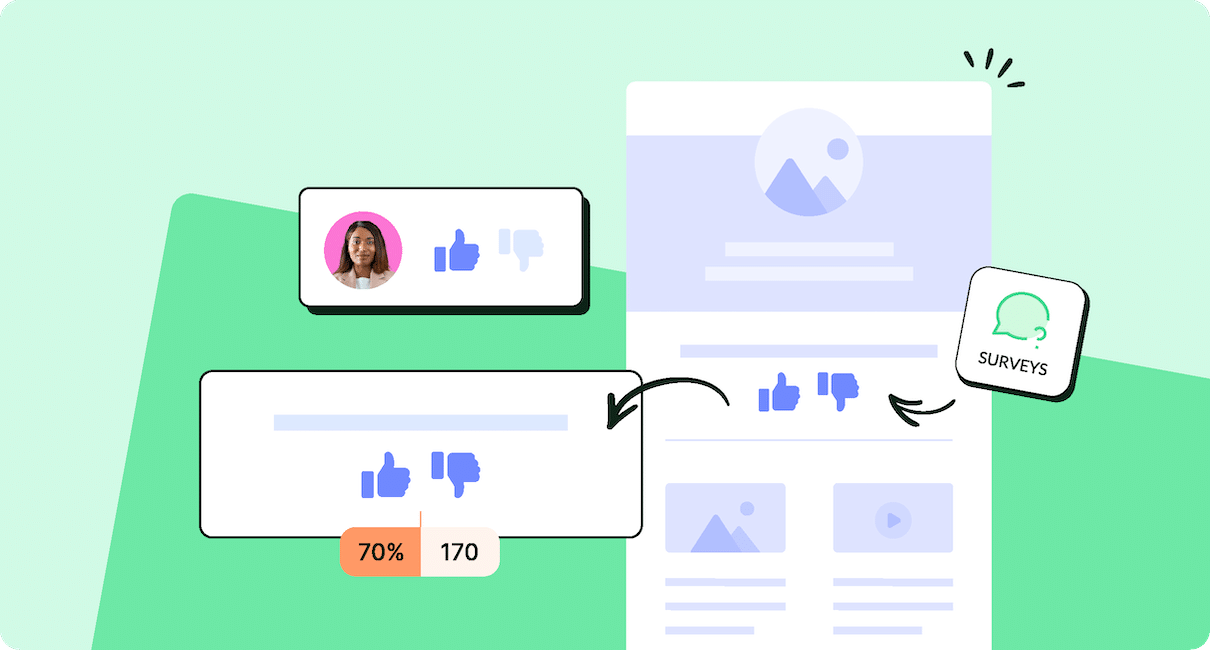Internal communication tools are no longer just a must-have for large businesses—especially in the age of remote work. In this post, we look at why small businesses and SMEs should use internal communications tools, and how to maximize their benefits.
When you’re sitting in a 2,000 sq foot office, opposite a team of 15-50 employees, it’s hard to imagine the need for a dedicated internal communications platform. If you have something to share, you can swing by a colleague’s desk in seconds.
Yet among the many things the COVID-19 pandemic has taught us, is just how easily this sort of close-knit work environment can be disrupted. The last few years have made it clear that remote and hybrid work are here to stay. As COVID updates and new protocols roll out quickly, the volume of internal communications that need to be sent out is also changing.
In light of this, investing in a dedicated internal communication tool is no longer just the responsibility of big enterprises. Large and small businesses alike need to have an internal communications plan and effective employee engagement tools to see it through. In this post, we’ll explore why to use an internal communication tool and which tools can make the biggest difference.
Revive employee engagement with targeted, interactive emails and newsletters
Book a 15 minute call with one of our team members
Why is Internal Communications Important?
It’s simple – internal communications are important to your business because they keep employees engaged and in the loop. Employee engagement is a leading driver of workplace productivity, innovation, and a handful of other business benefits.
Needless to say, these benefits don’t work in silos. They have a domino effect that impacts every business process, from customer experience, to employee retention and beyond.
If your internal communications don’t operate as they should, it becomes difficult for employees to get the information they need. When it’s hard to access vital resources and updates, it becomes challenging for employees to do their jobs well.
For dispersed and remote staff there are added difficulties. Not having a consistent link to their team through effective internal communications channels weakens relationships with colleagues. Your staff begin to work in silos and aligning priorities becomes a challenge.
Big or small—for teams to work effectively, they need to operate as a unit. That’s where effective internal comms, and reliable internal communications tools come into place.
Watch ContactMonkey on demand
Explore features to streamline your internal comms and measure impact.
Why Are Internal Communications Tools Important?
An internal communications tool helps small businesses maximize the benefits of their communications. They do this by ensuring that small business internal communications are in-sync, easy to access, and reach every employee on time.
Here are just a few other advantages of internal communications tools:
- Boost employee productivity by reducing information gaps.
- Strengthen company culture through cohesive internal branding and in-sync brand messaging.
- Enhance employee experience through clarity and ease of communication.
- Improve workplace retention by boosting employee engagement.
Small businesses may often find themselves needing to piggyback on their existing Marketing solutions for their internal comms needs. But stretching the use of external marketing tools to employee communications can raise a range of issues. For instance, external marketing tools, like Mailchimp, allow employees to unsubscribe from vital communications. This leads to many workers missing out on key company news or even crisis communications.
ContactMonkey’s all-in-one employee engagement software allows you to track workplace engagement while creating beautiful, professional internal emails. And it lets you do all this directly within Outlook and Gmail.
Not to mention, you can listen to employee insights using pulse surveys, eNPS survey questions, and anonymous comments.
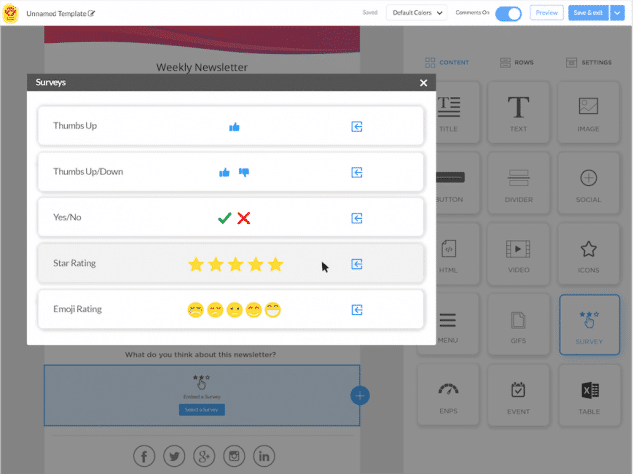
With ContactMonkey’s email tracking, you also have access to email open rates, click-through rates, opens by device, location, and more. This makes it easier to set yourself on a path to continuous improvement by tracking email metrics and building on successful campaigns.
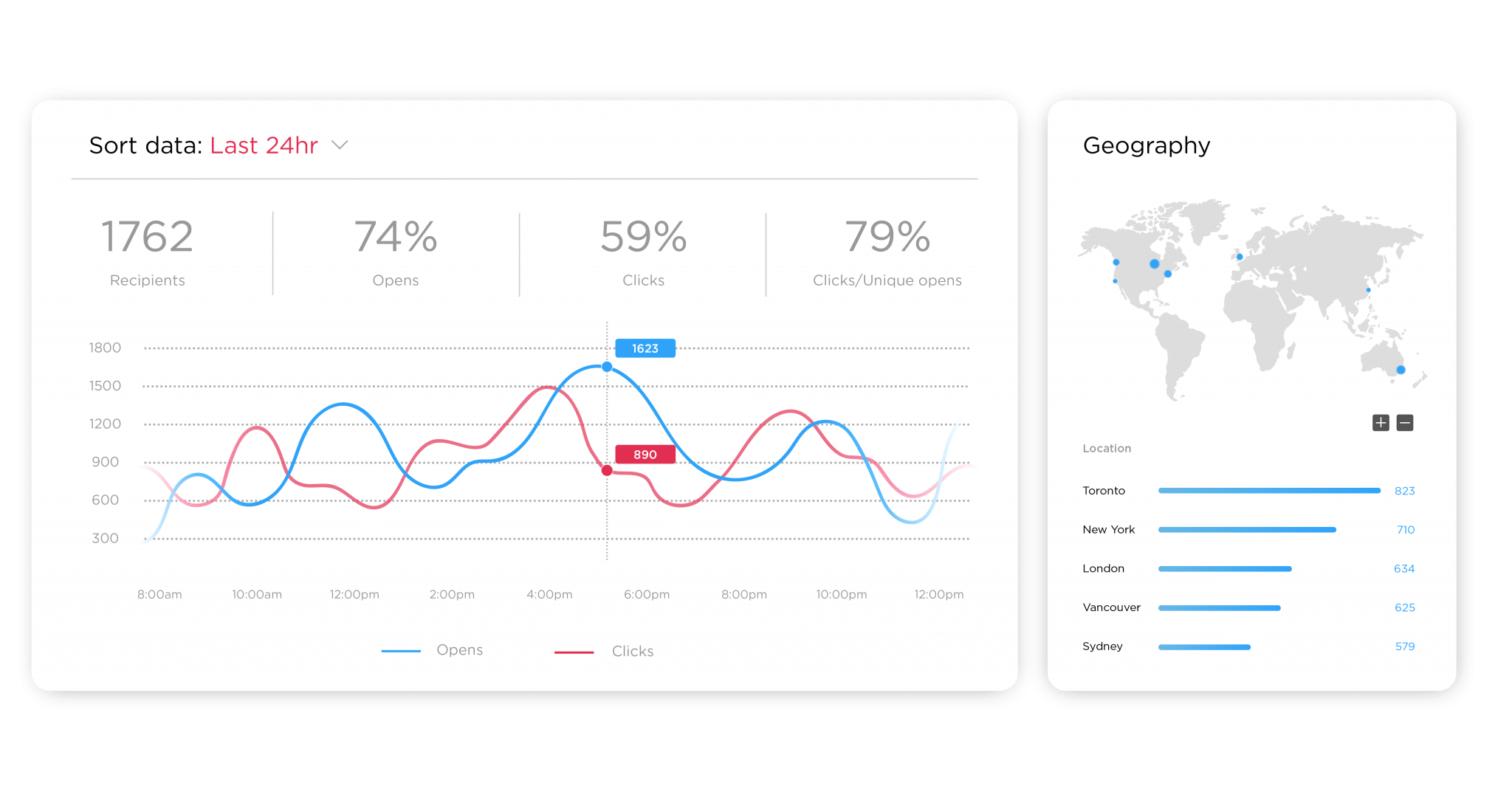
20+ Reasons Why Small Businesses and SMEs Should Use an Internal Communications Tool
It’s time to examine how an internal communications tool can help you achieve your goals in the business world. In particular, we’ll examine how an internal communications tool can cater to the unique needs of small and medium sized businesses.
1. Send better communications via Outlook / Gmail
If you’re like over 80% of businesses, you rely on Outlook, Gmail, or some combination of both for your corporate communication needs. But did you know that you can step up your Outlook and Gmail communications while boosting email open rates?
An internal communications integration lets you create and send customized internal newsletters right from Outlook or Gmail. ContactMonkey’s internal communications solution, for instance, allows you to send interactive messages, use Outlook hacks like add videos and images, and embed GIFs in your Outlook emails. Not to mention, you can track and measure the performance of your Outlook and Gmail emails to make strategic improvements to your messaging.
2. Create and send professional email designs
Adam Judge, an American designer and author once wrote, “The alternative to good design is always bad design. There’s no such thing as no design.” Put simply, design is always part of your communications, whether you’re actively investing in it or not.
Great email design helps organize your messages and make information more clear. But the truth is, many small businesses don’t have a dedicated designer on their team. An internal communications tool like ContactMonkey can help just about anyone on your team master email design in minutes. There’s dozens of pre-made HTML email templates to choose from, and a simple drag-and-drop menu lets you customize any elements:
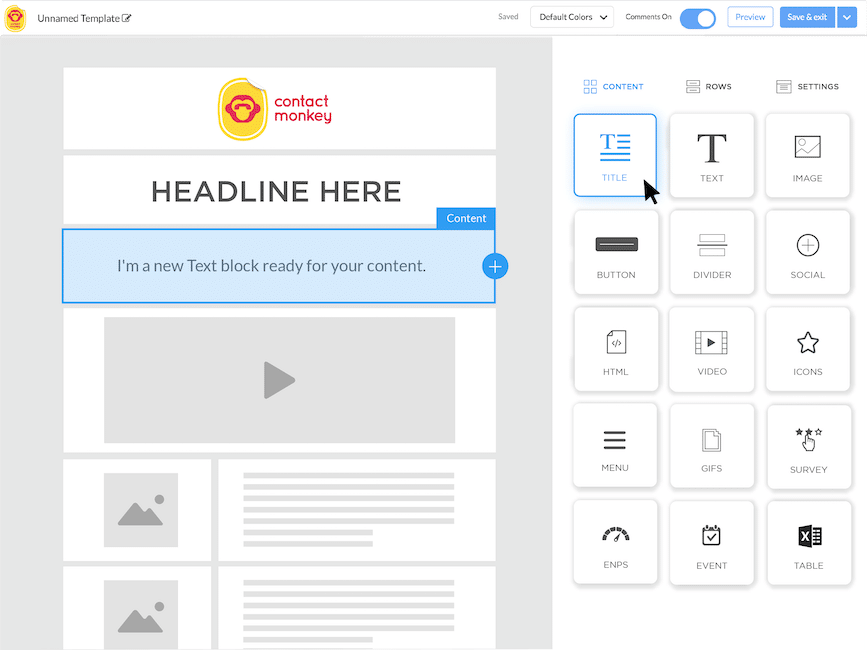
Want to leave the design to the experts? Take advantage of our email template design service, and see how our skilled in-house designers can help you take email engagement to a whole new level.
3. Send messages with video
Visual messages evoke a stronger emotional response from audiences. This makes them especially important when it comes to sending company culture, team building, or leadership communications.
With a video-compatible internal email tool like ContactMonkey, you can use your newsletter to send out embedded videos. Get creative and make funny clips that speak to your internal brand voice, or create onboarding and instructional videos. With ContactMonkey, you can do it all from your Outlook or Gmail newsletter. This type of communication is also sure to resonate with Gen-Z workers in particular.
Join us weekly for a live demo
Your questions about ContactMonkey, answered. Every Thursday at 12 PM ET.
4. Connect your workforce from anywhere and reach more employees
These days, both large and small businesses are faced with the common challenge of engaging and informing remote and non-desk employees. The transition to remote work can leave some employees feeling disconnected. An internal communications tool can help facilitate frequent, meaningful employee communications at scale.
ContactMonkey’s internal email software allows you to create, send, and track employee communications all in one place. Pre-made templates mean you only need to swap in the text to send new messages. And the Outlook and Gmail integration makes things even faster.
You don’t have to navigate between multiple platforms or embed lines of code to create responsive emails. Not to mention, you can easily add resource links, documents, and employee surveys all in one employee newsletter.
5. Promote peer-to-peer communication
An internal communication tool doesn’t just help you distribute information. It lets you transform your emails from a one-sided monolog into a dialogue. Interactive IC tools like ContactMonkey leverage embedded employee surveys, comment buttons, and emojil reactions to build conversations.
You can directly embed pulse survey questions on a range of topics within your employee emails. Alternatively, you can turn on anonymous comments to allow employees to leave feedback on specific newsletter features and updates.
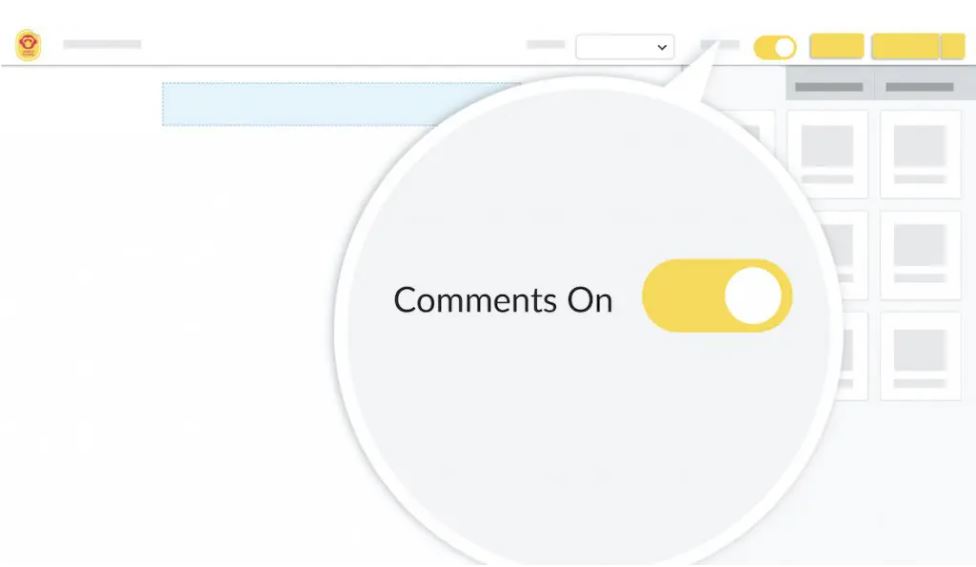
6. Communicate with specific audience groups in the company
Having a small team often makes it easier to involve everyone in company discussions. But there will be times when you’ll need to send individualized messages to specific groups or people. Internal communications tools that enable personalization make it easy to address specific individuals and groups, increasing their engagement with your internal updates.
ContactMonkey’s mail merge software lets you individualize both the subject line and body text of your email newsletters. You can automatically add the names of different employees in your distribution lists to your email header and copy. This humanizes your communications while making them more direct and personal.
7. Helps with efficient employee management
Likely one of the biggest reasons why small businesses and SMEs should use internal communications tools is their ability to improve business efficiency. Creating and sending employee messages without a dedicated internal communications platform is often slow and unreliable.
With an internal software, you have the ability to synchronize all your internal communications into a single platform. This makes delivering employee communications and resources faster. Not to mention, it becomes easier for your employees to access needed resources. In turn, it becomes easier for employees to do their job and this reduces conflict with managers, colleagues, and clients.
8. Boosts employee engagement / productivity
An internal communications tool can help you boost employee engagement through a two-phased approach. But it has to have two essential features to accomplish this: email tracking and interactivity. With ContactMonkey, you can track, measure, and boost employee engagement all at once, using these two simple components.
Email analytics let you easily monitor your best-performing content, and help you create more engaging emails. Meanwhile, interactive components such as pulse surveys and social reactions let your employees share their perspectives and ideas. By giving your employees a voice, and creating content that resonates with them, you’re instantly targeting some of the biggest drivers of employee engagement. And you’re doing it all with one simple tool.
9. Improve employee retention
Employee engagement and employee retention go hand in hand. In small companies and SMEs, where employees tend to wear many hats, keeping workplace turnover low is critical. By boosting employee engagement through fun, informative, and two-way communications, you’re automatically helping to improve employee retention. And that’s exactly what an internal communications tool is designed to do.
Not to mention, IC tools like ContactMonkey make it easy to ask staff about their engagement levels using embedded employee engagement surveys and anonymous comments. You can even conduct Employee Net Promoter Score (eNPS) surveys and have employees rate how likely they are to recommend your company to others:
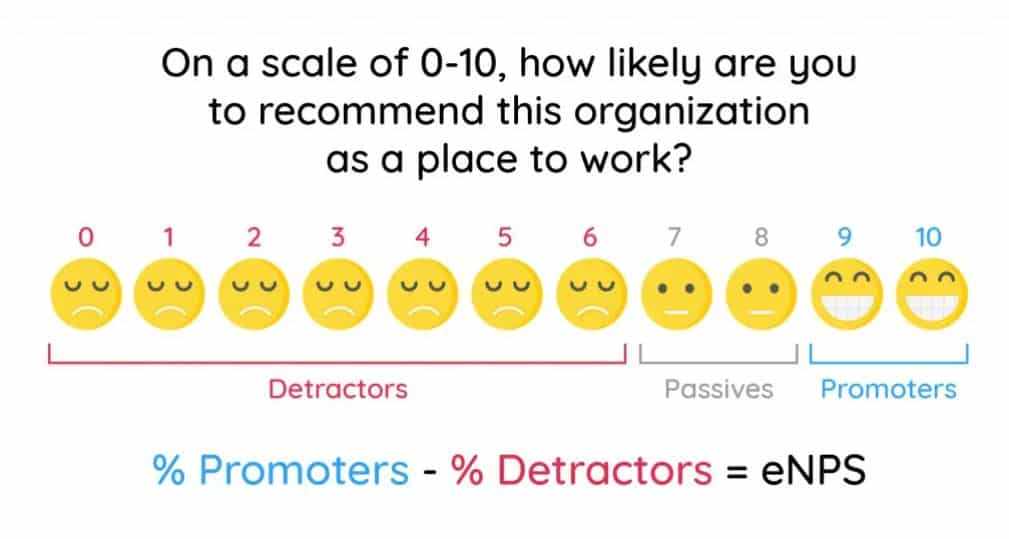
10. Strengthen teamwork and keep teams aligned
While siloed workflows are a top concern for large enterprises and university email marketing, small remote businesses can also suffer from this predicament. An internal communications tool that synchronizes all the different communications across your company prevents this. IT updates, marketing collateral, and sales targets are combined all in one place using an HTML email newsletter.
No one wants to read a laundry list of updates. But an easily scannable newsletter with distinct sections and visually compelling design makes sharing updates much more engaging. By staying connected with what other teammates are doing, your employees avoid working in silos and it becomes easier to encourage teamwork.
Not to mention, by consistently promoting team goals and objectives using your internal newsletter, you’re able to keep teams aligned more easily. In turn, you can encourage workers to share business goals, and drive business success.
11. Deliver a consistent supply of information and support workflow management
While there are many different types of internal communications tools and software, they do share a common goal. Namely, the objective is to help employees stay informed on key company news, while staying in touch with organizational values (via employee survey questions about company culture).
With an employee newsletter tool, for instance, you can embed multiple types of resources into one employee email. And you can do this without writing lines of lengthy texts and adding countless attachments. ContactMonkey’s smart links, for example, allow you to embed multimedia content directly into your internal newsletters. Once you send it off, you can track engagement with specific resources via click-through-rate analytics.
12. Improve employee experience
Employee experience involves many different factors. There’s work-life balance, employee engagement, pay and benefits, employee recognition, company culture, and so much more.
One thing’s for sure though, employee experience starts from day one, and it lasts all the way till your employee’s departure.
An internal communications tool makes it easier to check-in with your staff at every stage of their journey—whether you have 10 employees or 10,000. Schedule regular wellness check-ins, conduct employee satisfaction surveys, and gather anonymous feedback on employee experience—all from your internal newsletter.
13. Improve Employee Onboarding
With ContactMonkey, you can easily create an effective (and enjoyable) employee onboarding experience by combining a range of resources into one interactive newsletter. Send meeting agendas, equipment setup instructions, and all onboarding materials from one place.
This way, not only are new hires able to access everything they need to get started in one place, but they can leave feedback and ask questions to clarify concerns. You can even personalize the text of your new employee emails using merge tags, to make your new employee emails more welcoming.
Try ContactMonkey for free
Test-drive our platform for 14 days free.
14. Facilitate multilingual communication
Your business doesn’t have to be an international workforce, to benefit from multilingual emails. You may simply have employees whose first language isn’t English and who find it more comfortable to receive certain information in their native tongue. Safety surveys or legal documents with lots of technical terms are good examples of resources that may need translation.
Google translate is not always a reliable solution, but an internal communications tool with multilingual email support can be much more effective. With ContactMonkey, you have a variety of options for sending multilingual emails. We break them down in detail in our blog on all things multilingual emails.
15. Build and promote strong company culture
An effective internal communications tool helps convey your internal brand promise and company values. Consequently, it makes it easier to build a strong workplace culture.
For starters, the most important part of company culture is enabling ongoing dialogue with employees. By creating consistent feedback loops, interactive communications tools like ContactMonkey open up room for conversations and trust-building. They make employees feel seen and heard.
At the same time, ContactMonkey gives SME leaders the ability to create branded internal communications. This makes it easier to roll out a cohesive set of visuals, slogans, and value statements that represent your internal brand, inspiring employees with a clear vision and purpose.
16. Event management
The latest internal communications tools allow you to streamline event management. Internal communicators can now use ContactMonkey newsletters to drive registrations to an event directly from their Outlook inbox.
Your staff no longer get sent off to a third-party site and have to go through multiple hoops to register for an event. They can sign up right from their company newsletter. On your end, you’ll be able to see responses and RSVPs directly in your ContactMonkey dashboard.
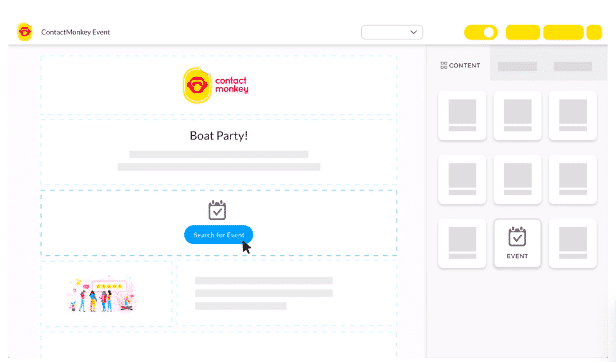
17. Crisis management
Crises can hit small businesses just as hard as big ones. And they usually occur when we least expect them. Staying proactive with a crisis communication plan is the first step to avoiding the worst of any storm. The second step is having an effective internal communications tool to distribute urgent updates.
You need a tool that can deliver messages quickly and which lets you track whether vital communications were indeed received. Email tracking software like ContactMonkey lets you know how many employees opened your emails, whether they clicked on key links, and even how long they read your email. Not to mention, using responsive email templates means you can create messages faster by simply copy/pasting new text, without needing to worry about formatting.
18. Change management
Guiding your team through a period of change can be one of the toughest experiences. There are many variables to consider and a constant flow of information to share. Ensuring that everyone is on the same page during your change management communications is critical.
An internal communications tool like ContactMonkey enables businesses to send high volumes of emails quickly with its easy-to-use email builder. But most importantly, the interactive elements allow employees to give feedback at every stage of the change communication process.
Employees can express concerns or ask questions in a totally confidential manner. Alternatively, you can conduct full-fledged change management pulse surveys straight from your email newsletter, and gather maximum insights ahead of the change process.
19. Check in on employees through fast, easy surveys
One of the biggest deterrents to completing a survey is the time it takes to do it. Employees often need to visit a third-party website and answer long lists of questions.
Internal communications tools with embedded pulse surveys remove the need for this hassle. You can conduct quick, simple, surveys on topics ranging from employee wellness, to workplace morale, worker safety, and everything in between. And with ContactMonkey’s internal email pulse survey solution, you can create, send, and track your surveys all in one place.
20. Avoid issues that stem from using external marketing tools
Finding ways to repurpose existing office tools in order to get the most out of them is a common practice across small businesses. And that’s understandable—you want to make your investment count. But cutting corners when it comes to internal communications tools can spell trouble.
In addition to enabling staff to unsubscribe from your internal emails, external marketing tools can compromise employee privacy. With Mailchimp, for instance, everything is run through their own servers. In other words, your employees’ personal information, and your company’s internal newsletters are hosted in third party servers.
This is bad news both from a cybersecurity perspective and from an employee engagement standpoint. Email services like Outlook often block digital elements and/or communications from outside servers. In the best case scenario, this means your internal email gets distorted by the time it reaches your employees. In the worst case, the email gets sent to your staff’s spam folder.
ContactMonkey sends emails from your own email servers every time. They are never uploaded to the web, and our newsletter templates are always responsive. This means you can guarantee employee privacy while ensuring that every HTML email looks great on mobile, tablets, and computers. You can also use your internal communications to alert your employees of new IT security risks and email phishing awareness training.
21. Help measure and optimize overall internal communication strategy/campaigns
Last but certainly not least, the biggest reason for why to use an internal communications tool is its ability to help you improve future email engagement. An internal email tracking tool lets you easily compare campaigns side-by-side, using powerful analytics.
You no longer have to spend your workday assessing and comparing individual campaign metrics. With a Campaign Comparison tool like ContactMonkey, you can analyze email analytics using one simple dashboard. Once you’ve gathered the necessary data, you can easily benchmark your campaigns against your best performing email newsletters. From there, it becomes easy to identify the content, design, and formatting that works best for your team, and use these insights to boost email engagement.
Why You Need to Use ContactMonkey’s Internal Communications Tool
It matters little whether you run a multinational business or a small startup—internal communications and workplace engagement will always go hand in hand.
With a reliable and multifunctional internal communications tool, your small business can keep employees informed and connected from absolutely anywhere. You can also gather valuable employee insights to improve employee experience, optimize your design thinking strategy for your internal communications, and retain employees longer. As your business grows, an IC tool will help you scale your communications without ever losing that personalized touch.
Still wondering why you should learn how to use an internal communications software? Book a free ContactMonkey demo to find out just how a dedicated internal communications tool can help your small business increase email open rates and boost employee engagement.
